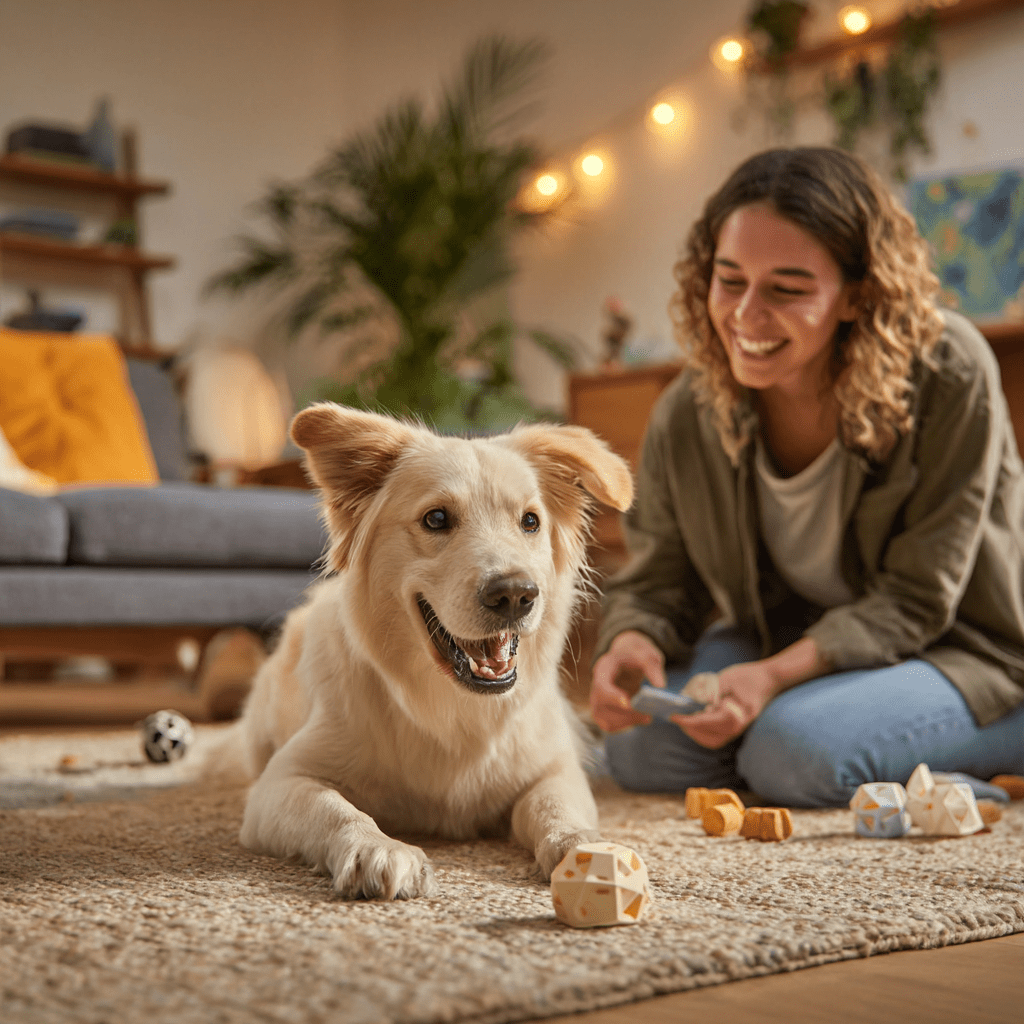Keeping your dog mentally stimulated and physically active doesn’t always require outdoor space or perfect weather. Indoor training games are an excellent way to build a stronger bond with your dog while teaching important commands, improving obedience, and preventing boredom-related behavior issues.
Whether you’re in an apartment, facing bad weather, or just want to engage more with your pet at home, this guide will walk you through fun and effective indoor games that both teach and strengthen your relationship with your dog.
🧠 Why Indoor Training Games Matter
Dogs, like people, thrive when they are mentally and physically engaged. Many pet owners focus solely on outdoor walks and forget that dogs also need:
- Mental stimulation
- Bonding activities
- Consistent training
Indoor games provide a controlled environment to reinforce behavior, boost confidence, and reduce stress. Plus, they’re just plain fun—for both of you!
🎮 Top Indoor Training Games for Dogs
1. 🧀 “Find the Treats” Game
Purpose: Encourages scent work and focus
How it works:
- Have your dog sit and stay.
- Hide treats around the room—under cushions, behind furniture, or inside toys.
- Release your dog with a cue like “Find it!”
- Praise and reward when they locate each treat.
Training benefits:
- Strengthens nose work
- Teaches patience and delayed gratification
- Builds independence and confidence
Pro tip: Use low-calorie treats or break them into small pieces to avoid overfeeding.
2. 🧩 The “Which Hand?” Game
Purpose: Encourages focus and scent discrimination
How to play:
- Place a treat in one of your closed hands.
- Offer both hands to your dog.
- Let them sniff, then paw or nudge the one they choose.
- Open the hand to reveal if they’re right!
Training benefits:
- Sharpens focus
- Builds problem-solving skills
- Reinforces positive behavior when played with consistency
3. 🪑 “Go to Your Spot” Game
Purpose: Teaches self-control and redirection
Steps:
- Designate a comfy mat or dog bed.
- Use the command “Go to your spot” and lure your dog with a treat.
- Once on the spot, ask for a down-stay.
- Reward calm behavior and slowly increase time spent there.
Training benefits:
- Creates a safe, calm place for overstimulation
- Reinforces boundaries and rest periods
- Useful when guests visit or during mealtimes
4. 🦴 Indoor Fetch with a Twist
Purpose: Burns energy and strengthens recall
Setup:
- Use a soft toy or ball suitable for indoor play.
- Toss it down a hallway or across a carpeted room.
- Ask for a “Drop it” or “Give” upon return, then throw again.
Training goals:
- Enhances recall
- Practices impulse control
- Encourages physical exercise indoors
Tip: Always clear the area first to prevent injuries or broken items.
5. 🧠 Shell Game (Cups & Treats)
Purpose: Develops memory and problem-solving
How to play:
- Use 3 cups and 1 treat.
- Place the treat under one cup while your dog watches.
- Shuffle the cups and encourage them to find the treat.
Benefits:
- Mental stimulation
- Builds confidence through success
- Fun way to engage your dog’s thinking skills
6. 🐾 Obstacle Course at Home

Purpose: Physical coordination and confidence building
What to use:
- Chairs, broomsticks, cushions, blankets
- Set up tunnels, jumps, and weave poles
How to teach:
- Lure your dog through each part of the course with a treat or toy
- Reinforce with verbal praise and small rewards
Advantages:
- Improves coordination and flexibility
- Great physical and mental workout
- Increases trust between you and your dog
7. 🐶 Tug-of-War with Rules
Purpose: Controlled excitement and impulse training
How it works:
- Use a sturdy tug toy.
- Teach “Take it” and “Drop it” commands.
- Play enthusiastically but stop if teeth touch your hand.
Why it helps:
- Encourages safe play
- Teaches self-control
- Satisfies your dog’s need for physical interaction
8. 🗣️ Name That Toy
Purpose: Vocabulary building
How to play:
- Pick a favorite toy and name it (“Ball”).
- Say the name while holding it, then toss it.
- Repeat often and gradually add more toys with different names.
Training perks:
- Builds cognitive skills
- Prepares for more complex commands
- Impressive party trick!
👩🏫 Tips for Making Indoor Training Effective
- Keep Sessions Short: Dogs learn best in 5–10 minute focused bursts.
- Always End on a Positive Note: Celebrate success!
- Use High-Value Treats: For indoor games, go for small, tasty rewards.
- Avoid Overtraining: Don’t overwhelm your dog; look for signs of fatigue.
- Mix Play and Learning: Dogs love to learn when it feels like fun.
❤️ Why These Games Strengthen Your Bond
Engaging your dog through play teaches them to trust, listen, and depend on you for fun and direction. This builds mutual respect and affection, which translates into:
- Better leash behavior
- Improved focus during distractions
- Greater happiness overall
Training isn’t just about commands—it’s about communication. Indoor games are a language both of you can understand.
🎯 Final Thoughts
Whether it’s a rainy afternoon or you’re looking for new ways to connect with your dog, indoor training games are the perfect solution. They nurture obedience, reduce unwanted behaviors, and deepen your emotional connection. Best of all, you don’t need a big backyard or fancy tools—just your time, love, and a few treats.
So the next time your dog looks bored, try one of these fun games. You’ll both be better for it.
